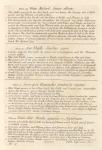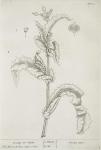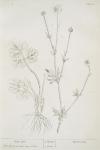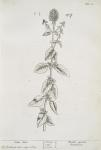

 29. White Mustard. Sinapi album.
29. White Mustard. Sinapi album.
Also see #028. Hedge-Mustard. - #029. White Mustard. - #068. Treacle Mustard.
1. The Stalks grow to be two Foot high, and are hairy; the Leaves are a light Green; and the Flowers a bright yellow.
2. It grows wild in dry Banks, and the Edges of Fields, and flowers in Iuly.
3. The Seed provokes an Appetite, strengthens the Stomach and helps Digestion. Dioscorides recommends the Juice mixed with Water and Honey as good to gargle the Throat with, and help Women who are troubled with the Mother; a Cataplasm of Figs and the Juice is good for the Lethargy, by laying it on the Head, shaved, till the place grows red, & the same Cataplasm laid on ye Hip eases the Sciatica. The Seed he recommends as good in Plaisters to soften ye Scabs of the Head.
4. Greek, Σίνησαι έτερον. Latin, Sinapi album or alterum. Spanish, Mostaxa blanco. Italian, Senape or Senauro salvatico. French, Seneve blanc. German, Gelber Senff. Dutch, Wit Mostard-Zaat.

 30. Sow Thistle. Sonchus asper.
30. Sow Thistle. Sonchus asper.
Also see #130, Smooth Sow Thistle.
1. It grows about two Foot high, the Leaves are a bright Green; and the Flowers a pale yellow.
2. This Sow-Thistle grows commonly on Banks, and flowers in May and Iune.
3. The Leaves are of the same Nature with those of the Dandelyon, being aperative and diuretic, and good for the Gravel and stoppage of Urine. Matthiolus says the roots and Leaves when young are much used in Italy in Sallads; & recommends the Milk of the Stalk in Wine as good for an Asthma; & the distempers of the Ear, when boiled with Oil. Galen recommends ye Leaves to be chew'd for an offensive Breath.
4. Greek, Σόγχος, Σόνχος. Latin, Sonchus asper. Spanish, Serraya or Serralba. Italian, Soncho, Cicerbita. French, Latteron. German, Bilder Hasentol or Gausdistel. Dutch, Gonse-distel.

 31. Crow-foot. Ranunculus pratensis repens.
31. Crow-foot. Ranunculus pratensis repens.
Also see #051, Pilewort or Small Celendine.
1. This Plant grows to be a Foot high, the Stalks and Leaves are somewhat hairy, the Flowers are a shining bright Yellow.
2. It grows in most Fields, and flowers in May.
3. Crow foot is caustic, and may be used to draw Blisters, where Cantharides cannot be had; but they must not ly on too long, for fear of ulcerating the Part. The Bavarians extol the distilled Water from the Leaves of the bulbous Sort, or the Leaves infused in Brandy, as an excellent Remedy against the Plague.
4. Greek, Βατράχιον και σέλινονάγριον, Πλατυφυλος. Latin, Ranunculus pratensis. Spanish, Yerva belida. Italian, Ranoncolo or Pie Corbins. French, Grenoillette or Bassiniz. German, Hanen Fuss. Dutch, S Anthonis Raapje.

 32. Water-Mint. Mentha aquatica or Sisymbrium.
32. Water-Mint. Mentha aquatica or Sisymbrium.
Also see #131, Water Calamint.
1. It grows to be 8 Inches high, ye Stalks are hairy; & ye Flowers a red Purple and ye Leaves a reddish Green.
2. It grows in Ditches and Watery-places, and flowers in Iune and Iuly.
3. This Mint is rather hotter than ye Garden-Mint, being carminative, expelling Wind out of the Stomach, & helping ye Collic; it opens Obstructions of ye Womb and procures the Catamenia. The Juice drop'd into the Ears is good to ease their Pain & help Deafness. Dioscorides recommends the Leaves boiled in Water as good to stop a Reaching or Vomiting.
4. Greek, Σισύμβριον. Latin, Mentha aquatica or Sisymbrium. Spanish, Berros or Agriris. Italian, Sisembro. French, -. German, -. Dutch, Rosse water Munt.

